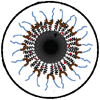Department of Physics and Astronomy: Publications and Other Research

Diandra Leslie-Pelecky Publications
Document Type
Article
Date of this Version
12-1-2002
Abstract
Measurements of DC susceptibility, AC susceptibility, and AC susceptibility with an applied DC bias field were performed on mechanically milled GdAl2. A paramagnetic phase exists above a temperature T ≈ 140 K. However, there are significant deviations from the Curie-Weiss Law in this temperature regime, suggesting multiple magnetic components. Fits to the high temperature data show that two Curie-Weiss terms represent the data quite well. Below 140 K one of these magnetic components becomes ferromagnetic as indicated by a shoulder in the AC susceptibility and DC susceptibility data. This ferromagnetic component is suppressed by the application of sufficiently strong DC bias field. Accompanying this shoulder is a peak at lower temperatures (T < 50 K), which suggests the existence of another component that is magnetically glassy in nature. The two-component behavior of mechanically milled GdAl2 can be explained in terms of the nanostructure of the material, which consists of nanometer-sized grains and a disordered interphase.


Comments
C. Stark, P.M. Shand, T.M. Pekarek, D. Williams, R. Brown, L. Yue, D.L. Leslie-Pelecky, American Journal of Undergraduate Research, 1:3, pp. 27-37 (December 2002). Online at http://www.ajur.uni.edu/v1no3/Stark_shand.pdf http://www.ajur.uni.edu/.